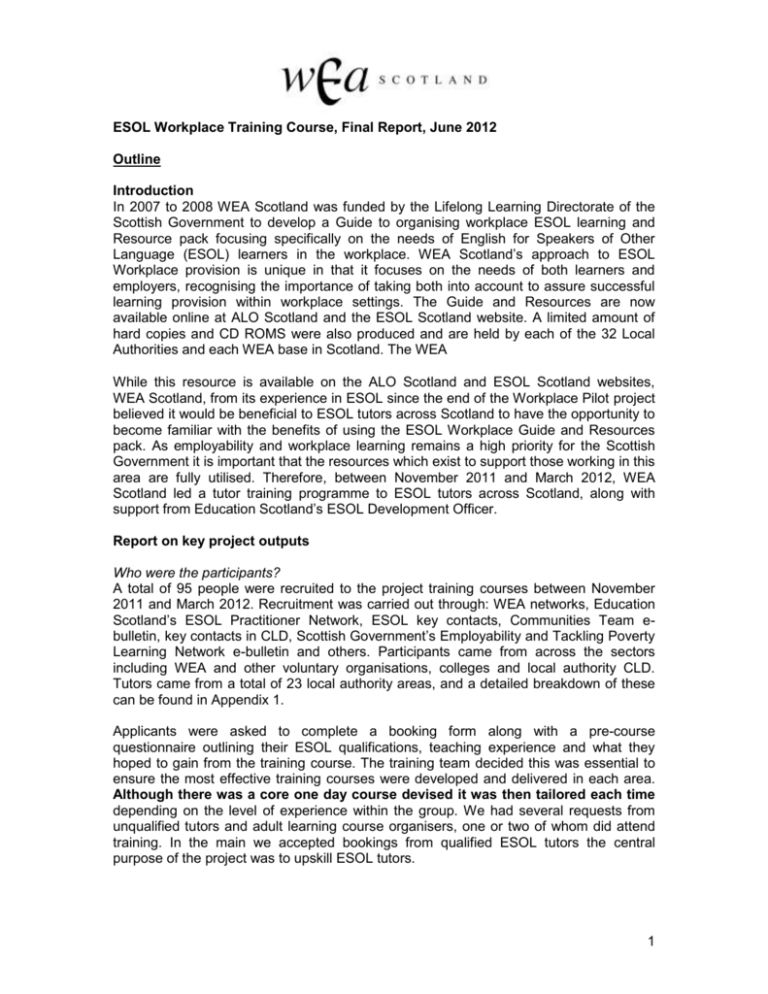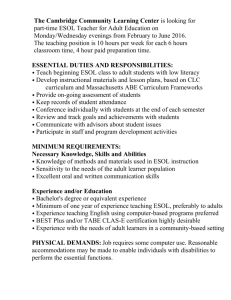ESOL Workplace Training Course, Final Report
advertisement

ESOL Workplace Training Course, Final Report, June 2012 Outline Introduction In 2007 to 2008 WEA Scotland was funded by the Lifelong Learning Directorate of the Scottish Government to develop a Guide to organising workplace ESOL learning and Resource pack focusing specifically on the needs of English for Speakers of Other Language (ESOL) learners in the workplace. WEA Scotland’s approach to ESOL Workplace provision is unique in that it focuses on the needs of both learners and employers, recognising the importance of taking both into account to assure successful learning provision within workplace settings. The Guide and Resources are now available online at ALO Scotland and the ESOL Scotland website. A limited amount of hard copies and CD ROMS were also produced and are held by each of the 32 Local Authorities and each WEA base in Scotland. The WEA While this resource is available on the ALO Scotland and ESOL Scotland websites, WEA Scotland, from its experience in ESOL since the end of the Workplace Pilot project believed it would be beneficial to ESOL tutors across Scotland to have the opportunity to become familiar with the benefits of using the ESOL Workplace Guide and Resources pack. As employability and workplace learning remains a high priority for the Scottish Government it is important that the resources which exist to support those working in this area are fully utilised. Therefore, between November 2011 and March 2012, WEA Scotland led a tutor training programme to ESOL tutors across Scotland, along with support from Education Scotland’s ESOL Development Officer. Report on key project outputs Who were the participants? A total of 95 people were recruited to the project training courses between November 2011 and March 2012. Recruitment was carried out through: WEA networks, Education Scotland’s ESOL Practitioner Network, ESOL key contacts, Communities Team ebulletin, key contacts in CLD, Scottish Government’s Employability and Tackling Poverty Learning Network e-bulletin and others. Participants came from across the sectors including WEA and other voluntary organisations, colleges and local authority CLD. Tutors came from a total of 23 local authority areas, and a detailed breakdown of these can be found in Appendix 1. Applicants were asked to complete a booking form along with a pre-course questionnaire outlining their ESOL qualifications, teaching experience and what they hoped to gain from the training course. The training team decided this was essential to ensure the most effective training courses were developed and delivered in each area. Although there was a core one day course devised it was then tailored each time depending on the level of experience within the group. We had several requests from unqualified tutors and adult learning course organisers, one or two of whom did attend training. In the main we accepted bookings from qualified ESOL tutors the central purpose of the project was to upskill ESOL tutors. 1 Eight courses were held, with the greatest demand being in Glasgow. Four courses were delivered in Glasgow, one in Inverness, one in Edinburgh, one in Peterhead and one video-conference course with tutors in Shetland. Meeting the key objectives 1. As a result of attending the training days ESOL tutors will have a sound knowledge and understanding of workplace issues in relation to their teaching and will be able to apply this to teaching ESOL in a workplace setting. 2. The numbers of ESOL tutors who are able to confidently deliver ESOL within a workplace setting will be increased. Therefore there will be a greater capacity to promote and deliver ESOL workplace provision throughout Scotland. 3. Through this course, the employability skills of ESOL tutors will be enhanced as they will be better placed to take up teaching opportunities in workplace settings. The training will provide ESOL tutors an opportunity to develop their continuing professional development. Summary of evaluative feedback on the training courses The project outcomes were fully met, with extremely positive feedback from participants as was clearly evidenced through course evaluations. Below is a summary of the key feedback points made through the evaluations. Length of course The majority of participants found the course to be of a good length. Only one or two noted that it was either too short or too long. Course delivery The delivery of the course was felt to be overall very good. Participants commented that they found the delivery varied, at a good pace, informal interesting and informative. People noted that the course was well delivered, that the materials were good and that it was very practical. Many people said that they enjoyed sharing experiences and ideas with their peers. Several noted that they will take back ideas and tools to their own organisations and implement within their teaching practice. In particular people enjoyed the videos, case studies and group work. Most helpful aspects The most helpful aspects of the course can be divided into 1) practical resources and 2) working with others. 1) lesson planning resources, action cards, pen drive, library, information on other ESOL provision, assessment materials, setting goals, course design, lesson planning, practical help in how to approach employers, ESOL Guide and Resource pack on USB, course organisation, what to think about when setting up a course, learning about the differences between ESOL workplace and ESOL community based learning, case studies. 2 2) meeting other ESOL practitioners, sharing experiences, working with others, group based activities, networking, hearing real life stories (DVD), being reminded of good practice. Gaps still to be addressed The courses attracted tutors from a range of tutoring backgrounds, and while the majority were ESOL trained, few had worked in workplaces. As a result the trainers had a difficult job on hand to ensure the course offered something to everyone. More information on lesson planning, cultural differences within workplace settings, more on how to deal with Health and Safety language and food handling without teaching it, higher language levels, how best to persuade managers that they would benefit from ESOL workplace, , working in mixed ability classes, sustaining motivation. Some participants expressed areas of development they felt they needed to address as ESOL tutors. For example some noted they need to use the ESOL pack and materials to develop their awareness of workplace ESOL in general. Others stated that they need to focus more on learners’ goals as well as employers’ goals. Increased understanding of delivering ESOL in the workplace The majority of participants stated that they have no previous experience in delivery of Workplace ESOL. All expressed the view that this course had greatly increased their understanding of the issues and practicalities of delivering ESOL in the workplace. Below are some comments from course participants: “I am new to this, so hugely increased understanding.” “Better ideas of the concept of workplace ESOL” “More aware of issues involved as I have not yet worked in workplace” “I feel I am better equipped to deliver ESOL in the workplace after this training session” “I was aware of many issues already for ESOL tutors, but some useful hints about how to approach employers and their needs.” “Have been using this tool/guide and feel I will use it more effectively”. “The course made me more confident and it has provided a very helpful structure” “I have a better understanding and the resource pack is great.” What are your plans as a result of this training course? Tutors had a range of plans for their next steps beyond the training course. Many noted their intention to seek employment in ESOL workplace learning either in a paid or voluntary capacity. Others intended to take what they had learned back to their organisations and discuss how their organisation could become involved in providing ESOL workplace learning. Some were able to see ways in which they could take what they had learned and use it in their community based and 1:1 tutoring. Many reported that they planned to improve their own practice as tutors, and in particular to consider more carefully the needs of learners in their lesson planning, rather than following a predetermined syllabus. 3 Additional outcomes achieved In addition to the set project outcomes there were important additional outcomes achieved. In summary: The course raised awareness of how a practitioner might need to adapt their teaching practice for ESOL workplace settings where target language is likely to be work related as opposed to what is expected in general English classes. ESOL Practitioners are encouraged to think about their practice and the context in which they work and to compare that with the context of delivering ESOL in the Workplace. By adapting practice for the workplace setting, learners improve their language skills which may result in them being able to sustain existing work, consider opportunities for promotion or take up opportunities in new types of employment. There was an opportunity to promote the ESOL case studies from Scottish Government, examples of effective practice in the provision and delivery of ESOL in Scotland. Course participants had the opportunity to join the national resource library held by WEA Scotland in its Glasgow base on behalf of Education Scotland. As a result of the training courses there has been a significant increase in the use of the resource library by ESOL tutors across Scotland. Course participants said they were keen to be involved in workplace learning but do not currently have the opportunity to develop it. If more tutoring possibilities arise, then there will be a greater bank of tutors who will be better equipped to tutor in ESOL workplace. The training team piloted the use of video-conferencing as a medium to deliver the course to tutors based in Shetland. While it has its limitations it was certainly a positive way of including ESOL tutors who would otherwise have struggled to gain access to the course. The training team learned a great deal from the experience which they would be able to use in other situations. Learning points for the future included: Remind learners not to mute their own discussions Send a copy of any CDs or DVDs to be used to the remote location in advance to enable group to watch them more easily. Explore ways of enabling participants to try out a broader range of practical activities Ensure that all the participants can be seen at the one time. Explore a further video-conference course where there is a group being trained in both locations so that there can be interaction between both. Potential for further development There is potential for training or support to adult learning providers who may be interested in developing ESOL in the workplace in their own areas. Therefore it may be that awareness raising courses could be developed for non-tutors across the sectors. There would be benefit in following up tutors who have participated in the training in 6 months time to find out what they have done as a result of the training. WEA Scotland will work together with Education Scotland to develop a survey through Survey Monkey to capture this evidence. This could include finding out how many were successful in obtaining workplace tutoring opportunities, whether they have used the resources and what they thought of them in practice in workplace settings. 4 Further work will be required to sustain a high profile and ongoing use of the ESOL Workplace Tutor Guide and Resource pack. It was evident from the project findings that Workplace ESOL is still being delivered in very few places. Some further development linked to awareness-raising could be carried out with Community Planning and Employment and Employability agencies. Perhaps this could be offered through new Upskilling funding in 2012/13. Consider rolling out training through video-conferencing to engage tutors from other parts of Scotland for example in the Western Isles and Orkney. The funding available only allowed for minor changes to the pdf document within the training course settings. To make the worksheets more accessible it would be helpful to be able to convert all the appendices to word documents. Connect could be a potential forum for tutors who have been part of this training project to discuss how they are getting on with workplace ESOL. In addition Connect could be used to initiate discussion on strands and aspects of what still needs to be done in terms of ongoing tutor training and support for delivering ESOL in the workplace. Appendix 1 Participant locations Location Orkney Shetland Highlands and Islands Aberdeenshire North Lanarkshire Glasgow Edinburgh Midlothian Fife East Renfrewshire West Dunbartonshire Scottish Borders 23 Councils + WEA Location West Lothian Dundee Stirling Perth and Kinross Clackmannanshire Argyll and Bute East Lothian North Ayrshire Falkirk Aberdeen City Moray WEA tutors 5







